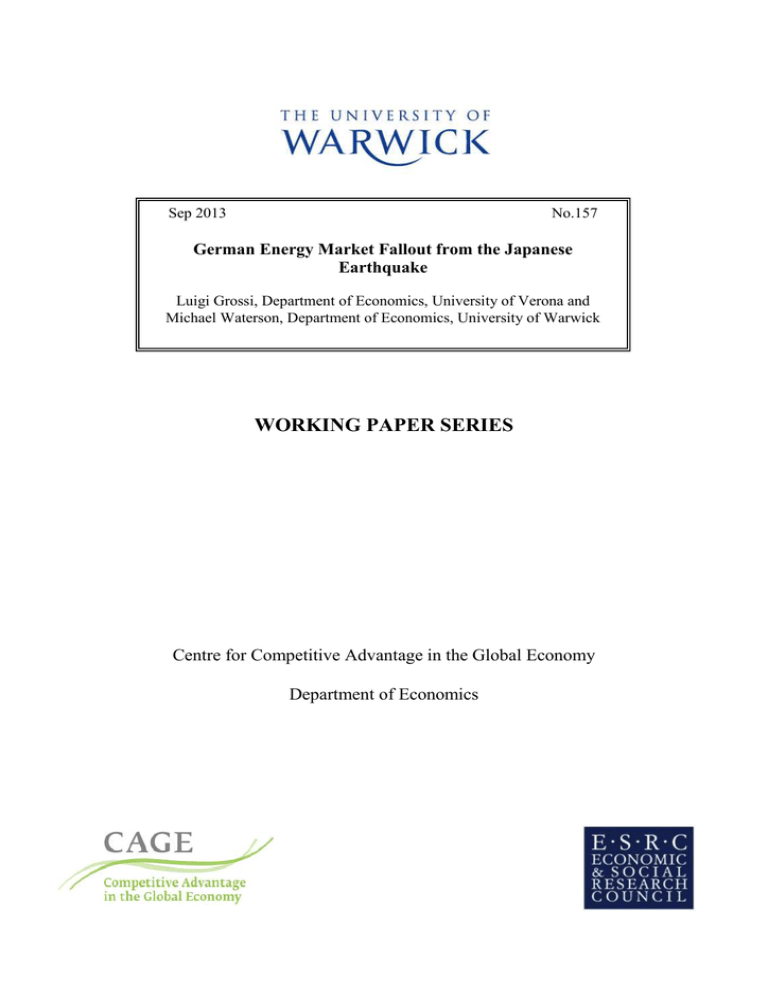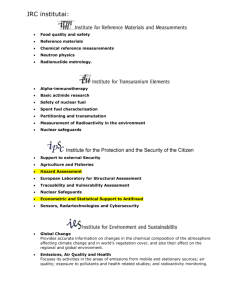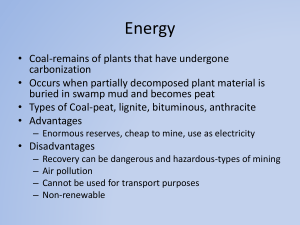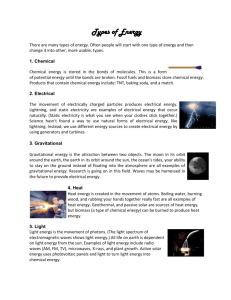German Energy Market Fallout from the Japanese Earthquake
advertisement

Sep 2013 No.157 German Energy Market Fallout from the Japanese Earthquake Luigi Grossi, Department of Economics, University of Verona and Michael Waterson, Department of Economics, University of Warwick WORKING PAPER SERIES Centre for Competitive Advantage in the Global Economy Department of Economics German Energy Market Fallout from the Japanese Earthquake Luigi Grossi Department of Economics, University of Verona luigi.grossi@univr.it Michael Waterson1 Department of Economics, University of Warwick Michael.Waterson@warwick.ac.uk Draft September 2013: Do not quote2 Abstract The German response to the Fukushima nuclear power plant incident was possibly the most significant change of policy towards nuclear power outside Japan, leading to a sudden and very significant shift in the underlying power generation structure in Germany. This provides a very useful natural experiment on the impact of changing proportions of conventional fuel inputs to power production, helping us to see how changed proportions in future as a result of policy moves in favour of renewables are likely to impact. We find through exploration of a conventional demand- supply framework that despite the swift, significant change, the main impact was a relatively modest increase in prices occasioned by a shift of the supply curve; there were no appreciable quantity effects on the market, such as power outages, despite some views that the impacts would be significant. Keywords—Atomausstieg; Demand-supply framework; German power market; nuclear power; renewables. 1 I am grateful for helpful comments received at a presentation of this paper at EARIE, Evora, Portugal in August 2013. 2 The estimates in this paper should be considered strictly as preliminary and subject to change, particularly in terms of magnitudes. A revised version of the paper will be available in due course authored by Luigi Grossi, Sven Heim (Mannheim) and Michael Waterson. 1 I. INTRODUCTION The German “Atomausstieg” decision to have a nuclear moratorium following the Fukushima nuclear disaster in Japan in March 2011 was unexpected and significant. Germany was heavily dependent on nuclear power; in 2010 over 22% of its power was from nuclear sources, but this decreased to less than 18% in 2011, the year of the earthquake [1] mainly as a result of the immediate closure for testing then subsequent permanent shutdown of six of the 17 plants producing nuclear energy in March 2011 (as well as two that were offline). As others have catalogued using event study methodologies ([2], [3]), although the market-anticipated profit impact on German renewable companies is significant, the profit impact on German power companies is rather limited. But arguably of more importance is the impact on the German power market itself. The Frankfurter Allgemeine Zeitung (31 May 2011), for example, estimates that the decision will cost the German people two billion euros per year and significantly reduce the stability of the system (quoted from presseurop, same date [4]). In addition, as the International Energy Agency has pointed out, one plausible impact is that carbon emissions increase due to increased burning of dirty coal (Guardian, 16 June 2011). In this paper, we examine the impact on the German market in terms of potential disruption to supply and in terms of price movements following the major unscheduled and unanticipated change created by the Atomausstieg decision. Clearly, the decision might have had a significant disruptive influence, leading to blackouts and selective supply reductions. There is no hard evidence this happened and we confirm that there is no discernible impact on the factors influencing demand. However in addition, a tighter demand-supply balance and change in fuel mix leading to greater variance in supply (given greater reliance on intermittent sources [5]) is likely to have impacted on wholesale prices for power, which again would have a wider effect on costs, not only in Germany but also in the markets most closely integrated with it. We investigate these issues within Germany using a conventional demand-supply framework, making allowance for the particularities of the German market as well as by using a dummy variable methodology to test for effects following the earthquake. To preview results, we find no evidence that demand (i.e. quantity supplied) was negatively impacted by the sudden decision. There is an impact on price - a movement up the supply curve, other things equal, resulting from the use of higher cost and less biddable fuel sources, but this is surprisingly modest in magnitude, although interestingly we find that the Frankfurter Zeitung’s estimates are near to our own. In our view, this outcome, if confirmed by investigations of sensitivities to modelling changes, is one with significantly wider ramifications.3 We could view the sudden change in German policy as an experiment in moving suddenly to a structure for power supply based on resources that are far more intermittent in nature, in which Germany is playing a key role (Figure 1). It therefore provides a potential pointer to the nature and scale of the much wider effects that may be anticipated as a result of a Europewide move to greater use of renewable energy sources [6]. II. IMPACT OF NUCLEAR DISASTERS ON ENERGY MARKETS: A LITERATURE REVIEW Business interests and environmental protection could maintain contrasting views. As a consequence, environmental regulators and policy makers take decisions which act in conflict with private companies’ short run interests because they increase production costs, restrict production, or otherwise constrain the actions of firms [7]. Sometimes decisions could even increase community costs related to the provision of energy. For instance, the decision to shut nuclear plants down after nuclear accidents could have negative effects on community in terms of higher electricity prices. There is a rich 3 We are currently investigating the issues further with more complete data and an additional author (Sven Heim, ZEW Mannheim), but our more complete analysis does not give rise to markedly different conclusions than those drawn here, at least in investigations to date. 2 literature in finance which studies the impact of nuclear disasters on stock prices, starting from the seminal paper by Brown and Warner [8] where the event study methodology was firstly applied to study the effect of an exogenous event on the US stock exchange market. The most dramatic nuclear accidents in the last decades happened at Three Mile Island in March 1979, at Chernobyl in April 1986 and, most recently, at Fukushima in March 2011. Figure 1. Nuclear and renewable sources for electricity generation in Germany 1991-2011 (TWh). Source: Federal Ministry of Economics and Technology, Federal Statistical Office, Working Group on Renewable Energies-Statistics (AGEE-Stat). Renewables include wind power, renewable hydropower, biomass, photovoltaic. The consequences of Three Mile Island disaster on the financial US market were studied by [9], [10] and [11]. The first two papers focused on the effect of the accident on returns computed on prices of U.S. utility stocks. Apart from the different models, the differences between the two papers concern the frequency of the data (daily and monthly). However, they found very similar results. Companies involved with nuclear electricity generation experienced significant negative abnormal returns and a statistically significant increase of market risk after the date of the disaster. In the second paper the authors examined the effect on financial returns of public utility companies. In the third paper, the authors examined the implications of the accident on bond risk-premia in the public utility industry. Applying various statistical techniques they found that the nuclear event caused a statistically significant upward shift of the risk-premia related to all U.S. electric utility bonds, with a particular impact on firms with nuclear-generating capacity. The effects of the Chernobyl nuclear disaster have been analysed by many papers. Among these, it is worth mentioning [12] and [13]. The first paper deals with the evaluation of the impact of Chernobyl disaster on the stock price of U.S. public electric utilities. The authors applied a classical event study analysis on daily time series and found statistical evidence of negative daily abnormal returns for all firms for a period of 20 days after the nuclear event. On the other hand, they didn’t find any significant change in the market risk. The second paper related to Chernobyl studied the reaction of U.S. stock prices by preliminary clustering companies according to their nuclear generation capacity. The authors found a statistically significant negative impact on returns and concluded that nuclear capacity influences the size of market returns’ reaction to the event. 3 Although the Japanese earthquake is quite a recent event, there are a number of papers dealing with the statistical evaluation of its economic and financial consequences. The main focus of this recent literature is, as with the previous nuclear accidents, on the influence on stock prices using mostly the event study methodology. The paper by Ferstl et al. [2] implements an event study experiment to assess the effect of Fukushima disaster and consequent governments’ decision on the stock market. Differently from prior literature this paper relies on a Fama-French model for stock returns instead of a simple market model. They analysed the nuclear and alternative energy industries in four countries: Japan, Germany, France and United States. A significant increase of uncertainty was observed on the prices of Japanese nuclear companies. By contrast the effect on stock prices in France and Germany was very quickly absorbed, meaning that the expectations of the market operators are towards a gradual shift from nuclear to alternative energies. The difference between Japan and European countries means that geopolitical considerations are vital for a successful energy transformation. Europe’s integrated electricity grid has enabled Germany’s relatively radical denuclearization without affecting energy service. However, Japan is unable to access electricity transmissions from neighbouring countries, and the fragmented nature of the national electricity grid has further exacerbated electricity supply. Betzer et al., [14] studies the shareholder wealth effects on electricity companies in Germany and in other European countries in the few days after the Fukushima nuclear disaster using the event study technique. The main findings of the paper indicate that the German reaction has resulted in a wealth transfer from nuclear energy companies to renewable energy companies. The same methodology applied by [2] and [14] has been used in [15] to assess the impact of the Japanese earthquake on stock prices of the Japanese electric utilities. The authors found that the prices of companies relying most heavily on nuclear power decreased more quickly than the prices of other electric utilities. They also observed a higher market risk linked to the operators’ perception of larger costs for operating nuclear plants. Although many papers were written on the effect of nuclear disasters on stock markets, no papers focused, to our knowledge, on the direct effect on electricity prices and generation mix. The present paper aims to fill this gap. III. MODELLING THE ELECTRICITY MARKET Underlying economic framework Conceptually, our model of the German electricity market has the following demand-supply structure, with the underlying assumption that the market clears and is approximately competitive; we have omitted time subscripts for simplicity. A. D = D(p, Ip, T, Cal, Du; error term) (1) S = S(p, W, C, CoalP, GasP, Cal, Du; error term) (2) S=D=V (3) This is a simultaneous equations system, with different equations relating to different times of day. Demand D is a function of price (p), industrial production (Ip), temperature (T), the day of the week, month, and year dummies (Cal), plus the earthquake dummy (Du) (that is the object of interest). Supply is a function of price, wind speed (W), cloud cover (C), wholesale prices for the key conventional generation inputs (CoalP and GasP), month and year dummies (Cal), earthquake dummy (Du), industrial 4 production and other things. Quantity supplied equals quantity demanded, and is the volume (V) of electricity. Given that we are talking about volume supplied and consumed, then this last equation is unexceptionable given the properties of electricity. Substituting the third equation into the first and second, we have two simultaneous equations determining price and quantity. By assumption demand does not depend on wind or cloud cover, nor does it depend on fuel input prices. Similarly, by assumption supply does not depend on temperature, the industrial production index or the day of the week. Under these assumptions, the equations are econometrically (over-)identified, given that each excludes more than one variable included in the other. The economic hypotheses and currently maintained assumptions behind this structure are as follows: Demand, particularly for space heating and cooking purposes, is influenced by ambient temperature [16], whereas wind does not appreciably impact on space heating demand. Cloud cover, so long as it is not particularly dense, will not affect demand either. Supply can be thought of as the sum of biddable and unbiddable supply. Biddable supply, i.e. gas and coal, responds only to price signals on the output and input markets. Un-biddable sources, such as wind power and solar power, are affected by wind speed and cloud cover respectively. Temperature, of itself, does not affect supply (i.e. by assumption the main driver of solar power is sunlight not heat). Assuming the supply equation is invertible (as it will be for most standard functional forms), we can rewrite this system as: V = V(p, Ip, T, Cal, Du; error term) (4) p = p(V, W, C, CoalP, GasP, Cal, Du; error term) (5) In principle, this pair of equations can be estimated using two stage least squares (2SLS). We choose a linear functional form for estimation and also include lagged price in (5) because the price series exhibits some autocorrelation. The reduced form uses the exogenous instruments of industrial production, temperature, wind speed, cloud cover and calendar dummies. Coal prices and gas prices on the wholesale markets are also assumed to be exogenous, given that the prices for these inputs are determined on a super-national basis rather than being set domestically within Germany. Empirical model and variable definitions The empirical model is composed of two equations representing (4) and (5). In the demand equation, electricity consumption ( Vt ) is regressed on prices ( pt ) and a set of other variables, that is B. WD WD Vt 01 11 pt 21Tt 31Tt 2 41 Ipt 51 Dt Y 61M DtM 71 D Yjt 81 DtE t1 (6) while in the supply equation, prices are regressed on electricity consumption and a set of other variables, that is pt 02 12 pt 1 22Vt 32 CoalPt 42GasPt Y 52Wt 62Ct 72M DtM 82 DYjt 92 DtE t 2 (7) where DtWD , DtM , DtY and DtE are weekly, monthly, yearly and earthquake dummies, respectively. The earthquake dummies have been fixed equal to 1 for 31 days after the earthquake. 5 All variables are daily time series collected from January 1st 2009 to August 22nd 2012. The volumes of electricity consumption ( Vt ) have been downloaded from ENTSOE (European Network of Transmission System Operators for Electricity) website. They are the net electricity consumption including network losses without consumption for pumped storage (in GWh). This variable is obtained as the sum of: - the amount of electrical energy supplied by the electricity service utility to end consumers of the network; - the amount of net electricity produced or imported directly from abroad by industrial or commercial companies on the network and used directly for their own needs or to supply end consumers directly; - the amount of electricity consumed by establishments (offices, workshops, warehouses etc.) of the electricity service utilities, but excluding the electricity absorbed by the auxiliaries of the power stations and the losses in the main transformers of the power stations, and that consumed for pumping and the network losses. For other details see https://www.entsoe.eu/. The original data base contains 24 values a day (one for each hour period), but we built daily time series selecting only three particular hours for each day (see section IV). Prices ( pt ) are measured in Euros/MWh. They have been obtained from the EPEX spot market, which offers Day-Ahead Auctions in the market areas Germany/Austria on every day of the week. In the auction, power for the 24 hours of the following day can be traded (http://www.eex.com/). Meteorological variables come from the Federal Ministry of Transport, building and Urban Development of Germany (http://www.dwd.de/). These variables are measured at standard times during the day that is at 7.30, 14.30 and 21.30. Variable Tt is the measurement of the air temperature at 2m high above ground. The original values are in degrees Celsius, but we transformed them in degrees Fahrenheit to avoid problems with mathematical transformations of negative valuesgiven that we plan to use a non-linear (quadratic) functional form in temperature in the demand equation. The wind force ( Wt ) is measured on a Beaufort scale which goes from 0, meaning absence of wind, to 12 in case of a hurricane. The degree of cloudiness ( Ct ) is the estimated cover with clouds of visible sky in oktas which goes from 0 when the sky is clear to 8 when the sky is completely covered. Temperature, wind force and cloudiness are measured in the main German cities. We selected 11 cities spread around the country in order to cover as much as possible the area of Germany, taking cities’ population in to account. Thus, in case of two very close cities, the more populous has been chosen. The ultimate variable included in the model is the average value computed on the selected cities. The industrial production ( Ipt ) index for Germany has been downloaded from the Eurostat website and refers to the total industry (excluding construction). The series is made available monthly and is computed as an index number with base year 2005. Data are adjusted by working days. CoalPt and GasPt are import price indices of hard coal and gas, respectively. They are produced monthly by the Federal Statistical Office of Germany. The base year is 2005. In the case of monthly time series, each day of the same month in our daily initial matrix has the same value. 6 Figure 2. Electricity spot prices (€/MWh) on the EPEX market (upper panel) and electricity consumption (GWh) in Germany (lower panel). Figure 3. Average electricity prices for each month of the year, at different times of day. Figure 2 reports the time series plot of electricity prices (upper panel) and electricity consumption (lower panel) at hour 14.30. In this case prices are the average values of hour 14 and hour 15, while consumption refers to the period 14-15. As can be seen, prices are quite stable along the observation period, in other words no long-term trend is detectable. On the other hand, periodical price fluctuations are observed which are connected to monthly seasonality. This is evidenced in Figure 3, where the average price is computed considering prices observed in each month of the year. Whatever the observed hour is, the highest prices are always observed in the final months of the year. 7 Figure 4. Average electricity consumption on each day of the week, at three different times. Weekly seasonality is not observable in Figure 2 because the data are too compressed. However, the effect can be clearly noticed in Figure 4, where average consumption is computed relating to data collected at the same day over the period considered. As is to be expected, average electricity consumption tends to be much lower during the week-end. Table 1 contains the main descriptive statistics of the dataset we use to estimate model (6)-(7). One noticeable feature is that negative prices are occasionally observed on the German market (as in many other electricity spot markets), mostly at night and early morning because plant flexibility is limited and stop-start operation is costly. Thus incurring a negative price for an hour can nevertheless be economically optimal overall [17]. The other feature worthy of note is the considerable variance experienced in almost all the data series. 8 Table 1. Variables in the dataset: summary statistics Electricity Prices (€/MWh) Electricity Cons. (GWhx1000) Temperature (Faharenheit) Wind force (Beaufort Scale) Cloudiness (Oktas) Coal Prices Index Gas Prices Index lPI Hour median mean CV* min max 7.30 48.97 47.38 0.38 -50.6 120.03 14.30 46.63 46.64 0.28 -0.74 103.65 21.30 46.36 46.63 0.18 17.88 75.21 7.30 58.06 55.14 0.18 32.05 73.96 14.30 61.91 59.19 0.15 33.96 76.38 21.30 55.89 55.51 0.11 39.06 71.77 7.30 46.06 45.8 0.29 3.76 74.64 14.30 56.17 54.89 0.29 11.55 92.17 21.30 53.42 52.62 0.29 9.29 90.78 7.30 2.10 2.23 0.28 1 5.8 14.30 2.73 2.84 0.25 1.18 5.36 21.30 2.36 2.46 0.25 1.18 5.18 7.30 6.00 5.50 0.34 0.09 8.00 14.30 6.09 5.67 0.30 0.09 8.00 21.30 5.73 5.42 0.34 0.18 8.00 179.10 180.77 0.09 154.6 224.10 154.40 154.27 0.18 108.9 195.20 104.10 104.11 0.09 86.9 119.80 * CV = Coefficient of Variation obtained as the ratio of standard error over mean. IV. RESULTS AND DISCUSSION Table 2 gives our estimates of the model as set out in (6) - (7). The results in the first three columns give results for three representative times of day, 07:30, 14:30 and 21:30 in respect of equation (6) whilst the other three columns are the equations explaining prices at the same times of day. It can be observed that the demand curve is downward sloping, as expected, whilst the supply curve is upward sloping. Also, sufficient variables attain statistical significance for us to be confident that the equations are statistically identified. We do not detail the coefficients on the calendar dummies, but these take on sensible signs. In more detail, demand is significantly influenced by price (negatively), temperature (with a quadratic functional form) and the industrial production index (positively), so that all have their expected signs, it is also impacted by calendar values. There is no evidence that demand has been constrained following the decisions on nuclear power stations; if anything the opposite. Supply price is significantly affected by quantity (positively), gas price (positively), lagged price (positively) and wind speed (negatively). All these signs are as expected. Also, as may be anticipated, the price is impacted positively by the dummy for the decision on nuclear plants. 9 Table 2. Estimated coefficients of model (6)-(7). Demand Equation Explanatory Variable Price (s.e.) Temperature F (s.e.) Temperature sq (s.e.) Ind prod index (s.e.) Dummy (s.e.) Lag price (s.e.) Coal price (s.e.) Gas price (s.e.) Demand (s.e.) Wind (s.e.) Cloud (s.e.) R sq 07:30 -101.9 (38.91) -472.2 (95.38) 4.57 (1.01) 297.0 (100.4) 1958 (1012) 14:30 -47.24 (30.64) -409.8 (67.66) 2.98 (0.58) 198.0 (80.52) 923.3 (810) 0.757 0.795 Supply Equation 21:30 07:30 -75.7 (30.03) -451.6 (45.77) 3.46 (0.41) 232.5 (58.5) 1227 4.24 (544.2) (2.22) 0.007 (0.024) -0.006 (0.042) 0.167 (0.0032) 0.0016 (4E-05) -7.51 (0.529) 0.300 (0.182) 0.821 0.688 14:30 21:30 3.33 (1.42) 0.087 (0.024) 0.072 (0.027) 0.060 (0.02) 0.0011 (3E-05) -5.74 (0.287) 0.006 (0.012) 0.726 2.70 (1.04) 0.463 (0.0049) -0.0020 (0.0019) 0.0073 (0.0016) 0.0004 (4E-05) -3.04 (0.262) -0.005 (0.008) 0.664 Note: standard errors in brackets. Coefficients in bold are significant at better than 5%. Calendar dummies also included, but not reported here. Table 3 below illustrates some calculations based on these estimates in order to establish magnitudes for the various effects. We note that at the median value of temperature, as temperature increases, demand falls. As we reach around the third (upper) quartile of temperatures experienced, demand levels off and then rises as temperature increases. This is the expected quadratic influence of temperature on demand, with most of the range exhibiting a negative relationship since increasingly less power is needed for spaceheating purposes. Once temperatures reach sufficiently high levels though, power becomes used more for cooling purposes so that the curvature reverses. Demand is rather price inelastic at the mean (with elasticities less than 0.1 in absolute terms); this is in line with conventional wisdom for the current market. It is rather more elastic with respect to temperature (at the mean) and the industrial production index, both values being around 0.4. On the supply side, the elasticity of supply is mostly in the region of 0.6, somewhat higher in the evening. Although supply price is significantly influenced by the gas price, particularly in the morning, the elasticity is significantly less than one, as would be expected. Most importantly, given our topic, the decision to close nuclear plants had the effect of around a 7% uplift in wholesale power prices, all other things equal. This is significant. However, in order to scale it, the effect is similar in magnitude to a 0.5 decrease in average wind speed on the Beaufort scale, which is roughly the effect of moving from the third quartile to the median wind speed. At least in terms of the mean value, this suggests that as more wind power is brought to the grid, the detriment to prices (from consumers’ point of view) is likely to be ameliorated significantly. 10 Table 3. Calculations based on estimates in Table 2 and summary statistics in Table 1. Slope at: median 3rd quartile Effects of temperature on demand 07:30 14:30 21:30 -51.2 -75.0 -81.9 45.2 -7.0 -0.6 Price Temp IPI Elasticity of demand with respect to mean value of: 07:30 14:30 21:30 -0.087 -0.037 -0.064 -0.392 -0.380 -0.428 0.561 0.348 0.436 Demand Supply* Gas price Supply price elasticity with respect to mean value of: 1.865 1.396 0.476 0.536 0.716 2.101 0.545 0.198 0.024 Price Percentage impact of earthquake dummy at mean value of: 8.97 7.14 5.79 Percentage Effect of a 0.5 increase in average wind speed at mean value of: Price -7.940 -6.154 -3.258 * Inverse of elasticity to Demand V. CONCLUDING REMARKS Our results suggest that the sudden bold decision made by the German government to mothball significant parts of its nuclear fleet did indeed have an impact in terms of higher prices for German consumers. It did not lead to disaster, but it did imply on average a 7% price penalty as a result of a combination of factors. We envisage that the penalties included a tighter supply-demand balance, a shift to less efficient sources of fuel (possibly carrying a higher penalty in terms of carbon price) and a need to redraw the balance between exports and imports of power. In this, Germany was perhaps lucky because it is relatively well connected electrically with all its neighbouring countries, particularly Austria and Switzerland, so that it can rely upon the resilience afforded by these interconnections. Thus we intend in developing this work to extend our analysis in order to incorporate some features of the wider picture within central Europe. Through this and sensitivity testing of the maintained modelling structure incorporating more time periods we aim to obtain greater precision regarding the effect of the German decision. Nevertheless, our tentative results also provide some insight into the future in terms of movements in the power market as European economies rely to a greater extent upon intermittent sources of energy, something in which Germany is taking the lead. 11 REFERENCES [1] BDEW [German association of water and energy industries] (2011) Brutto-Stromerzeugung nach Energieträgern, available at http://www.bdew.de, unpublished document. [2] R. Ferstl, S. Utz, M. Wimmer (2012), The effect of the Japan 2011 disaster on nuclear and alternative energy stocks worldwide - an event study, Business Research, 5(1), pp 25-41, available at http://www.business-research.org/2012/1/finance/3309. [3] Lopatta K, T Kaspereit (2012), The effect of the Fukushima nuclear accident on stock prices of firms with nuclear, renewable and conventional energy production, Working paper, available at SSRN: http://ssrn.com/abstract=1993016. [4] Presseurop (2011), Where does German nuclear exit lead to?, available at http://www.presseurop.eu/en/content/article/687031-where-does-nuclear-exit-lead. [5] Ketterer J. C. (2012), The impact of wind power generation on the electricity price in Germany, Ifo Working Paper No.143, Leibniz Institute for Economic Research, University of Munich. [6] J. Huenteler, T. S. Schmidt and N. Kanie (2012), Japan's post-Fukushima challenge – implications from the German experience on renewable energy policy, Energy Policy, Vol. 45, pp. 6-11. [7] J. B. Bushnell, H. Chong and E. T. Mansur (2009), Profiting from Regulation: An Event Study of the EU Carbon Market, NBER Working Papers 15572, National Bureau of Economic Research, Inc. [8] S.J. Brown and J. Warner (1985), Using Daily Stock Returns: The Case of Event Studies. Journal of Financial Economics, vol. 14 (1), pp. 3-31. [9] R. M. Bowen, R. P. Castanias, and L. A. Daley (1983), Intra-Industry Effects of the Accident at Three Mile Island, Journal of Financial and Quantitative Analysis, vol. 18 (1), pp. 87-111. [10] J. Hill and T. Schneeweis (1983), The Effect of Three Mile Island on Electric Utility Stock Prices: A Note, Journal of Finance, vol. 38 (4), pp. 1285-1292. [11] W. B. Barrett, A. J. Heuson, and R. W. Kolb (1986), The Effect of Three Mile Island on Utility Bond Risk Premia: A Note, Journal of Finance, vol. 41 (1), pp. 255-261. [12] M. A. Fields and V. Janjigian (1989), The Effect of Chernobyl on Electric-Utility Stock Prices, Journal of Business Research, vol. 18 (1), pp. 81-87. [13] R. Kalra, G. V. Henderson jr. and G. A. Raines (1993), Effects of the Chernobyl Nuclear Accident on Utility Share Prices, Quarterly Journal of Business and Economics, vol. 32 (2), pp. 52-77. [14] A. Betzer, M. Doumet and U. Rinne (2013), How Policy Changes Affect Shareholder Wealth: The Case of the Fukushima Daiichi Nuclear Disaster, Applied Economics Letters, vol. 20 (8), pp. 799-803. [15] S. Kawashima and F. Takeda (2012), The effect of the Fukushima nuclear accident on stock prices of electric power utilities in Japan, Energy Economics, Vol. 34 (6), pp. 2029-2038. [16] C. C. Lee, Y. B. Chiu (2011), Electricity demand elasticities and temperature: Evidence from panel smooth transition regression with instrumental variable approach, Energy Economics, Vol. 33 (5), pp. 896-902. [17] E. Fanone, A. Gamba, M. Prokopczuk (2013), The case of negative day-ahead electricity prices, Energy Economics, vol. 35, Special Issue on “Quantitative Analysis of Energy Markets” (eds. A. Gianfreda and L. Grossi), pp. 22-34. 12





